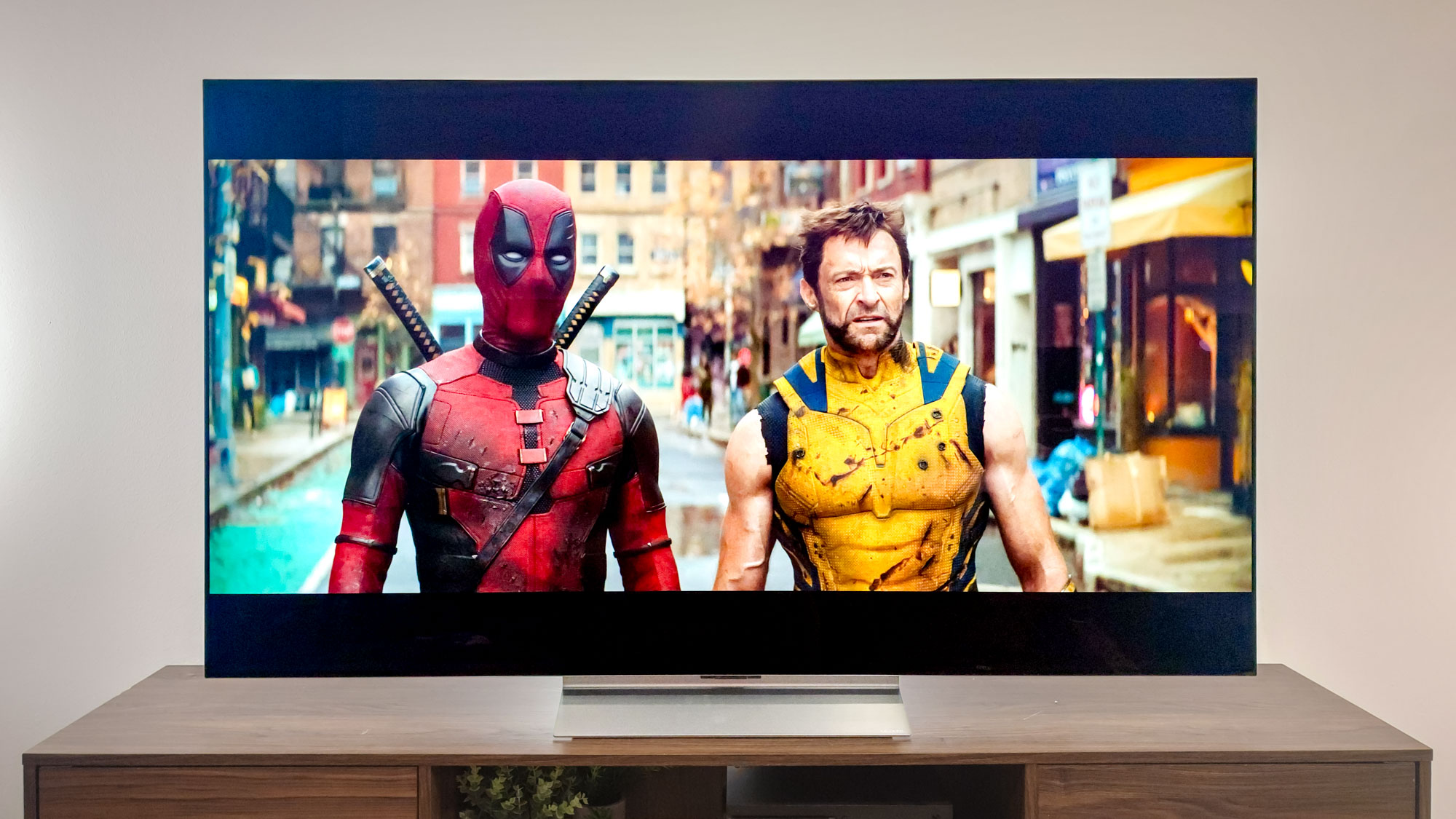Tom's Guide Verdict
Despite high photo quality and sophisticated controls, this selfie-friendly shooter awkwardly straddles the cellphone and 'real' camera worlds.
Pros
- +
Lush but not oversaturated colors
- +
Good high ISO performance for its class
- +
Slim, attractive design handles well
Cons
- -
Detail does not compare to that of larger mirrorless cameras
- -
Autoexposure sometimes fails
- -
9mm slim lens distorts photos and limits shooting options
- -
Not suited for nighttime photos or video
- -
Poor at capturing the selfies that are meant to be a key feature
Why you can trust Tom's Guide
Samsung's NX mini mirrorless camera fills the space between cellphones and point-and-shoots on one side, and DSLRs and mirrorless cameras on the other. Starting at $450, the NX mini's 1-inch, 20.5-megapixel sensor makes the device small enough to fit in your pocket, but it's larger than you'd find in a smartphone, allowing you to capture better-quality images. But this intriguing device is considerably smaller than what you'll find in other interchangeable-lens cameras. That places some limits on the kind of photos you can shoot, especially in low light.
MORE: Best Mirrorless Cameras
Design
Cute, playful and nostalgic are all good words to describe the NX mini. It has the same general shape and finish as Samsung's larger NX300 and new NX3000 cameras: a slablike, "rangefinder" design with faux-leather wrap. In addition to the conservative brown, white and black color options of its siblings, the NX mini is available in a pale, early 1960s-style mint-green shade and a bright pink that would fit well in the movie "Legally Blonde."
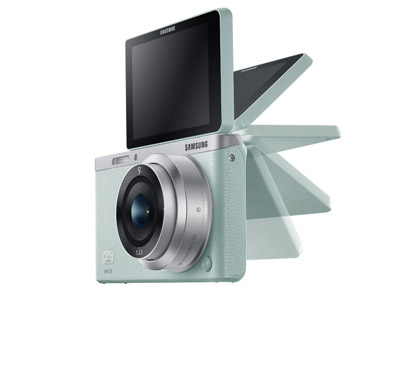
The NX mini is comfortable to hold, perhaps because its design is familiar, kind of like a chubbier smartphone. It measures 4.4 x 2.4 x 0.9 inches. The 3-inch touch-screen LCD furthers the camera phone experience but goes a step further with the ability to tilt upward 180 degrees for framing selfies.
The NX mini includes a built-in flash as well as a tiny port for mounting a larger flash up top. The $450 base model comes with a half-inch-thick, "pancake-style" wide-angle lens. The flash is part of the $500 kit, which includes a 3X zoom lens in place of the 9mm pancake lens. (Note that the 9mm figure is the focal length, which is not the same as the physical size of the entire lens mechanism.)
Controls
The NX mini manages to squeeze in a good suite of controls for shooters who take it out of Auto mode. The 10 buttons to the right of the screen include a red record button in the upper-right corner. A Mode button, just below, cycles through shooting modes, including Auto, Smart (presets for subjects like Landscape or Food) and Shutter and Aperture Priority modes, among others.
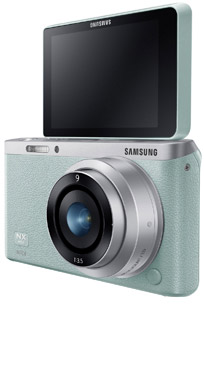
A circular arrangement of four buttons, with a fifth in the center, lets you access such settings as Shutter Speed, Aperture and ISO (light sensitivity). The buttons also serve as directional keys for navigating on-screen controls.
Unusual for an entry-level and even for many midrange mirrorless and DSLR cameras, the NX mini provides a customizable button for fast access to settings. The button all the way on the bottom right deletes photos in playback mode, but can let you access one of six functions during shooting, such as One Touch WB (white balance). This setting, which allows you to custom-tune color for difficult lighting such as orangey nighttime interiors, is often so buried on cameras that it's too much trouble to adjust. Here, it's a cinch.
MORE: DSLRs vs. Mirrorless Cameras
You can access more settings on the touch screen by tapping the respective icons (or navigating via the directional keys) for items such as Shutter Speed, Aperture or Metering Mode. The screen can also be set to take a photo focused on the part of the frame you tap, just as many cellphones allow you to do.
Considering how small the NX mini is, it scores well in our test of how easy it is to access key settings, thanks, in part, to its large touch screen.
| Setting | Steps/buttons presses | Function |
|---|---|---|
| Shutter | 1 | Length of exposure |
| Aperture | 1 | Amount of light let in |
| ISO | 2 | Light sensitivity |
| Focus mode | 2 | Point of points used for focus |
| Light metering | 2 | Part of image with optimized exposure |
| White balance | 2 | Overall color cast of image |
| Exposure Compensation | 2 | Set auto exposure to be darker or lighter |
| Wi-Fi sharing | 1 | Send images to smartphone, activate remote viewfinder |
| Video recording | 1 | Switch from photo to video and back |
| Play | 1 | View images or videos you've shot |
| Delete image | 1 | Erase photo from card |
| Photo size | 2 | Number of megapixels |
| Photo quality | 3 | Amount of JPEG compression/detail, or RAW |
| Video resolution | 4 | Lines of resolution and frame rate |
| Video quality | 5 | Amount of compression/detail |
| Drive | 1 | Single photo, burst, timer, etc. |
Image quality
The NX mini's 1-inch sensor is about one-third the size of the APS-C type sensor found in most DSLRs and mirrorless cameras (including Samsung's). The Nikon 1 is the only other interchangeable-lens camera line to use a 1-inch sensor. Its various models are a tad larger, but price competitive. The newly announced Nikon 1 S2 starts at $450 with a 11-27.5mm zoom lens. Some high-end point-and-shoots, like the Sony RX 100 II, also have a 1-inch sensor.
Cramming 20.5 MP onto such a small sensor can hurt the ability to capture detail, especially in low light. However, like the Nikon 1 and 1-inch Sony models (and many smartphones), the NX mini uses a back-side illuminated sensor that allows more light to reach the pixels than a standard CMOS sensors would.
For testing, Samsung provided the $450 package of the NX mini, which includes the pancake lens with a very wide 9mm focal length (equivalent to 24.3mm on a full-frame camera). This focal length is wide enough to capture up to three people in a selfie when you hold the camera at arm's length, but it produces some nasty distortion. For more on lens performance, see "Kit Lens," below.
Bright-light results
Daylight photos taken with the NX mini showed stunning colors, whether depicting foliage or fashion. In its default color mode, the camera pushes color to the edge of oversaturated, but doesn't go too far. Images in a park showed bright springtime green leaves and a rich blue sky, and didn't completely blow out the skin tones on a pale skateboarder we met.

Skin tones in other portraits were also true to life across a range of complexions. In a photo of four women — three with dark skin and one with very light skin — everyone was represented accurately.
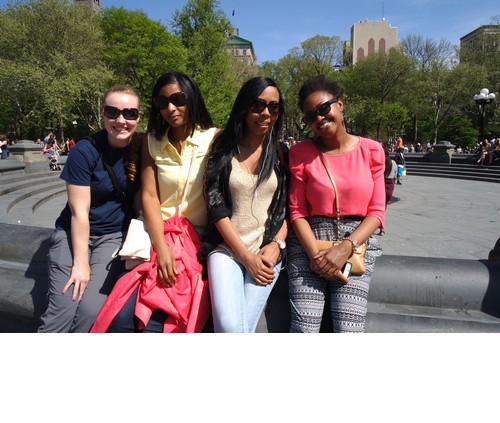
Light metering was inconsistent. When the NX mini succeeded, it performed very well in its default matrix (tuned to the whole frame) autoexposure mode. However, sometimes the light metering seemed to get confused, producing images that were way overexposed. In another photo of the same four women, taken split seconds before the successful example, the whole scene is blown out. (We saw similar problems in several other photos.)

If the light-to-dark range is extreme, you can engage one of two special modes. Samsung's Smart Range+ makes sure images aren't blown out, as we saw in a challenging scene of people sitting outside a café shaded by a building with brightly painted murals. Farther up, the scene was exposed to brilliant sunshine.
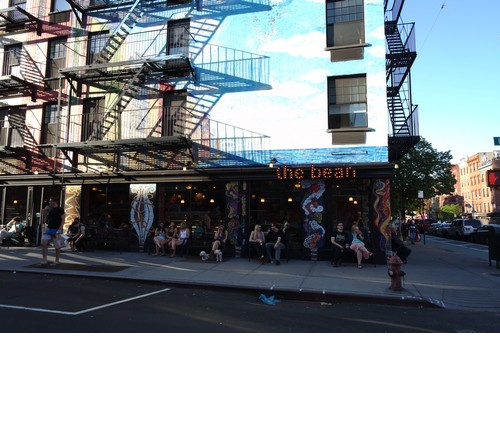
Smart Range+ mode didn't do a lot to brighten up the shadows, but it toned down the overexposure on the murals, bringing out richer color and more detail.
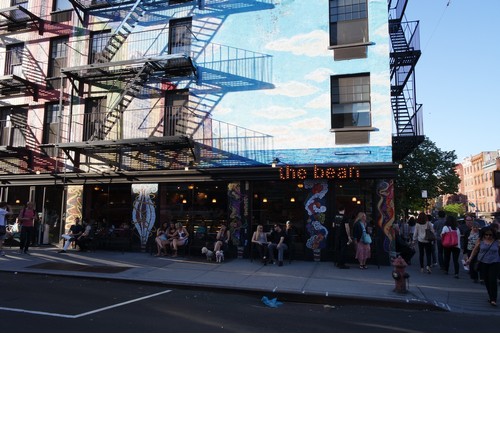
Samsung's other mode, HDR (high dynamic range), snaps multiple photos at different exposures and combines them to lighten up the shadows and tone down the highlights. In the same scene, HDR mode significantly lightened up the shadowy area where people were sitting. The top of the building was a bit too bright in the image, but less so than in a regular photo by the NX mini. Since HDR takes multiple photos, movement between shots can show up as a slight blur, so it's not a cure-all.
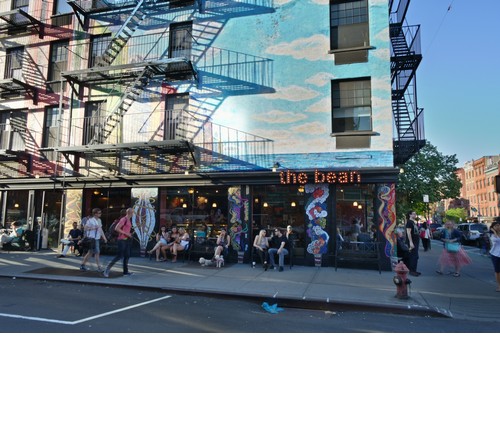
Combining the photos took several seconds of processing, which delayed us from shooting more. In general, processing after HDR or burst photos, video or sometimes even single photos felt especially sluggish.
The photos showed quite a bit of detail, given the camera's sensor and lens constraints. A mandala-style artwork done in colored sand looked very sharp at about 25 to 50 percent of the full image size — plenty for Facebook, Tumblr or even Flickr posting. At full size, however, the details were a bit soft and not at all comparable to what you would get from a high-end sensor and better lens, such as Samsung's own NX30 kit. Of course, that package costs $1,000.
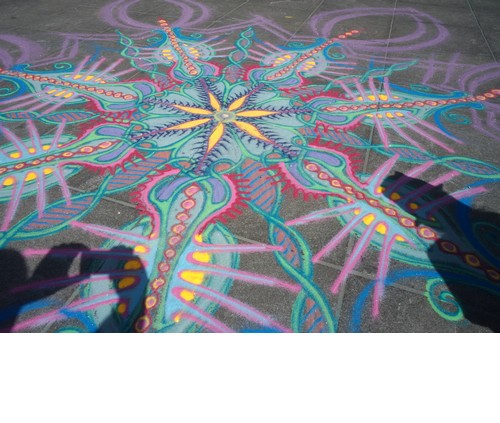
Whether this loss of detail matters could depend on how you see this camera fitting into your photographic repertoire. The detail is at least as good as, and generally better than, you'd see in point-and-shoot and smartphone cameras. However, it doesn't compare with any but the weakest mainstream mirrorless and DSLR cameras.
Low-light performance
The NX mini does surprisingly well for a camera with such a small sensor. In an image of flowers shot under a shady tree in the early evening, details looked sharp up to ISO 1600, in line with what some of the weaker interchangeable-lens cameras with APS-C sensors can do. That allowed us to get up to a very fast shutter speed of 1/250 second, suitable for action shots.
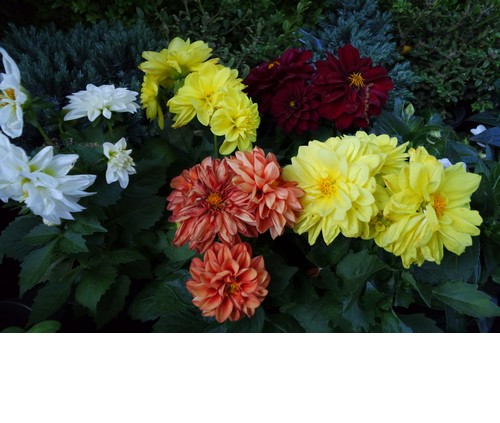
When shooting a café at night, even ISO 1600 wasn't enough to capture a bright image, and required a too-slow 1/10-second shutter speed that made blur from camera shake unavoidable. So, the NX mini is an acceptable camera for dim, but not truly dark, environments.
The camera has a built-in flash, but it's overpowering because the wide lens required us to get in people's faces. When we tried to brighten up what would have been a dim photo of a barista, the flash rendered his light-coffee skin tone eerily pale.

A note about our testing: We shoot photos simultaneously in JPEG and RAW, to see the camera's ultimate capabilities versus any quirks in how it produces the JPEGs. Given the NX mini is targeted to casual shooters, we primarily judged the quality of JPEGs and also shot more (though not exclusively) in auto settings than we did when testing higher-end cameras aimed at photography enthusiasts.
Video quality
The NX mini can shoot at up to full-HD resolution of 1920 x 1080 pixels (or 1080p) at 30 frames per second, which is typical for entry-level mirrorless and DSLR cameras. The latest generation, such as the Nikon D3300, achieves the top-spec 60-fps rate.
Video quality was adequate. A clip of children chasing soap bubbles in a park was clear enough and relatively smooth. (This unintentionally became an LOL video as the little girl slipped. She was fine afterward.) Sound was palatable from the tiny built-in stereo mics, but they didn't capture much detail or sonic range, and they did pick up peripheral noise.
Low-light video performance
The NX mini is not a strong performer in low-light video. We shot a clip of people on a New York evening, and the results looked rather dim. And because the included lens is not image stabilized, our footage appeared a bit shaky. The camera was also slow to adjust focus as we panned.
Autofocus and speed
The NX mini does not have the advanced phase-detection autofocus found in DSLRs and newer mirrorless cameras. (For more on focusing tech, see Camera Wars: Why Autofocus is the New Megapixel.) Like nearly all point-and-shoot and cellphone cameras, the NX mini uses only sluggish contrast-detection autofocus, but it performed surprisingly well given that limitation.
Under bright light, the NX mini locked focus fast enough to not be distracting (except on rare occasions, when it took a shot before focusing). We pretty much got the photo of someone or something as it happened. Even in dim lighting conditions, the Samsung was relatively quick. The NX mini didn't hunt interminably as some other cameras with similar focus tech, such as the otherwise-strong Olympus OM-D E-M10.
Wireless and GPS
A tap on the wireless button atop the NX mini turns it into a wireless hotspot that you can connect to a smartphone's Wi-Fi settings. If you have an Android smartphone with an NFC chip, you can simply tap it to the camera to set up wireless pairing.
After the devices are connected, you open the Samsung Smart Camera app (for Android or iOS). If you haven't reprogrammed the wireless button on the camera, it starts Autoshare by default. Copies of subsequent photos you shoot are sent to the phone at your choice of full resolution or 2 MP (the latter is plenty for uploads).
You can select other wireless modes by pressing the Mode button on the back of camera and selecting Wi-Fi. Among the choices are Remote Viewfinder, Baby Monitor (which turns the mini into a wireless camera) and Auto Backup (which automatically transfers up to 1,000 photos from your camera wirelessly to your computer). You can also reprogram the wireless button on top of the camera to activate any of these modes.
Remote Viewfinder makes your smartphone screen a replacement for the NX mini's LCD. You'll see a live preview of what your photo or video shot will be. Control options are limited to setting the photo or video resolution, the flash mode and whether the camera shoots single or multiple shots or shoots on a timer. You can also enable Touch AF: Tapping the smartphone screen sets the focus point and snaps a picture.
Kit lens
Samsung offers two kit options for the NX mini. (It does not sell a body-only option.) The $450 base package comes with a thin prime (nonzooming) "pancake" lens of 9mm focal length (equivalent to 24.3mm on a full-frame camera). This is a rather wide lens meant for selfies, when you have to hold the camera out front at arm's length and can include a friend or two. However, lens distortion ruins many shots.

In a three-person selfie, the two people on the ends had noticeably wider heads than the guy in the middle, and they looked slightly warped. Even in a two-person photo of women we handed the camera to, one looked larger than in real life, but her right arm, near the center of the frame, was freakishly scrawny. You can see further distortion on the women's sunglasses. In each case, the lens toward the outside of the frame appeared wider than the one toward the inside. (The photo is also overexposed.)
Lenses and accessories
The $500 kit includes a more useful 9-27mm zoom lens. In full-frame camera terms, this translates to 24.3-72.9mm. It begins at the extrawide selfie mode of the pancake lens, through how the unaided eye sees the world (about 50mm) and on to a slight telephoto length. This lens includes optical image stabilization, which is key for getting sharp photos in low light and video with minimal jitter. This package also includes an external flash that's about twice as powerful as the built-in unit.
But with the zoom lens, you'll have to compromise on portability. With the pancake lens, the NX mini slips into a front jeans pocket. But with the zoom lens, it's about 0.7 inches thicker (1.2 inches in total), making it tough to get into a pocket. Whichever kit you purchase, you can buy the other lens separately. The 9mm lens sells for $180 and the 9-27mm zoom sells for $280 (though we weren't able to find either available from online retailers at the time of the review).
Samsung has announced a third lens, with a single focal length of 17mm (equivalent to 50mm), a large aperture of 1.8 and image stabilization. If you want to save some space by going with a prime lens, this is the most flexible focal length ideal for portraits as well as most other shots in a small area that don't require telephoto to make items appear closer. Samsung hasn't announced a price, an availability date, or whether this lens will be part of a kit.
And Samsung hasn't said yet if it will produce more M lenses. You can attach lenses from Samsung's lineup of about 12 NX models, using an adapter. (Samsung hasn't specified a price yet.) This takes you far from the NX mini's slender aesthetic.
Bottom line
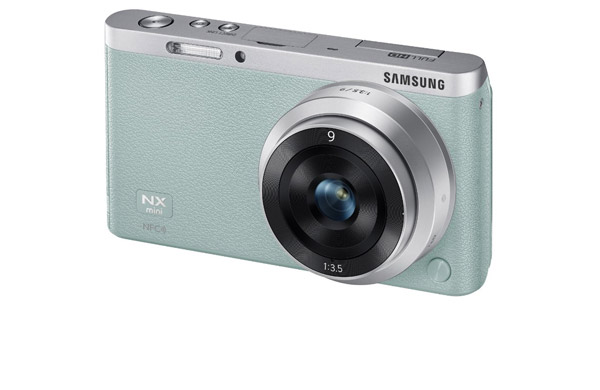
When viewed in terms of pure performance versus size and price, the NX mini is impressive. Colors are rich, detail is good enough, high ISO performance is better than expected and exposure generally succeeds. Likewise, autofocus (though based on low-end tech) is relatively snappy. Other cameras' mirrorless cameras perform better, but they cost more and don't fit into a jeans pocket.
But is all that enough to justify the price or the inconvenience of carrying a device in addition to your smartphone? Our conclusion is no, especially with the distorting wide-angle lens that ruins the selfies it's meant to capture. Samsung has promised to send us the zoom lens soon. If this lens eliminates the worst distortion problems (at least at longer settings) and offers sufficient image stabilization for low light, that package may earn a higher score. But we don't recommend the NX mini version with the pancake lens we tested.
| Specs Table | |
| Samsung NX mini | |
| MP Size | 20.5 MP |
| Camera Type | Mirrorless camera |
| Price | $450 (with 7mm lens) ; $500 (with 9-27mm zoom), no body-only option |
| FPS | 5-fps burst mode |
| Sensor | 1-inch BSI CMOS sensor |
| Auto-focus | Contrast-detection AF (no phase detection |
| Shutter Speed | 1/16,000 - 30 sec |
| ISO | 100 - 25,600 |
| Video resolution | 1920p, 720p, 640p at 30 fps |
| Flash | Built-in flash; hot shoe (for external flash only) |
| Storage | microSDXC |
| Ports | microHDMI, micro USB ports |
| Wi-Fi | 802.11b/g/n |
| Battery | 2,330 mAh |
| Lens image stabilization | optical with 9-27mm kit lenses |
| Size | 4.4 x 2.4 x .89 inches |
Sean Captain is a freelance technology and science writer, editor and photographer. At Tom's Guide, he has reviewed cameras, including most of Sony's Alpha A6000-series mirrorless cameras, as well as other photography-related content. He has also written for Fast Company, The New York Times, The Wall Street Journal, and Wired.

